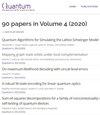Expanding Hardware-Efficiently Manipulable Hilbert Space via Hamiltonian Embedding
IF 5.1
2区 物理与天体物理
Q1 PHYSICS, MULTIDISCIPLINARY
引用次数: 0
Abstract
Many promising quantum applications depend on the efficient quantum simulation of an exponentially large sparse Hamiltonian, a task known as sparse Hamiltonian simulation, which is fundamentally important in quantum computation. Although several theoretically appealing quantum algorithms have been proposed for this task, they typically require a black-box query model of the sparse Hamiltonian, rendering them impractical for near-term implementation on quantum devices.In this paper, we propose a technique named $\textit{Hamiltonian embedding}$. This technique simulates a desired sparse Hamiltonian by embedding it into the evolution of a larger and more structured quantum system, allowing for more efficient simulation through hardware-efficient operations. We conduct a systematic study of this new technique and demonstrate significant savings in computational resources for implementing prominent quantum applications. As a result, we can now experimentally realize quantum walks on complicated graphs (e.g., binary trees, glued-tree graphs), quantum spatial search, and the simulation of real-space Schrödinger equations on current trapped-ion and neutral-atom platforms. Given the fundamental role of Hamiltonian evolution in the design of quantum algorithms, our technique markedly expands the horizon of implementable quantum advantages in the NISQ era.
利用哈密顿嵌入扩展硬件高效可操作希尔伯特空间
许多有前途的量子应用依赖于一个指数大的稀疏哈密顿量的有效量子模拟,这一任务被称为稀疏哈密顿模拟,这在量子计算中是至关重要的。虽然已经提出了一些理论上有吸引力的量子算法来完成这项任务,但它们通常需要一个稀疏哈密顿量的黑盒查询模型,这使得它们在量子设备上的近期实现不切实际。在本文中,我们提出了一种名为$\textit{Hamiltonian embedding}$的技术。该技术通过将稀疏哈密顿量嵌入到更大、更结构化的量子系统的演化中来模拟所需的稀疏哈密顿量,从而通过硬件高效的操作实现更高效的模拟。我们对这种新技术进行了系统的研究,并证明了实现突出量子应用的计算资源的显着节省。因此,我们现在可以在实验上实现复杂图(如二叉树,胶合树图)上的量子行走,量子空间搜索,以及在电流捕获离子和中性原子平台上模拟实空间Schrödinger方程。鉴于哈密顿进化在量子算法设计中的基本作用,我们的技术显着扩展了NISQ时代可实现量子优势的视野。
本文章由计算机程序翻译,如有差异,请以英文原文为准。
求助全文
约1分钟内获得全文
求助全文
来源期刊

Quantum
Physics and Astronomy-Physics and Astronomy (miscellaneous)
CiteScore
9.20
自引率
10.90%
发文量
241
审稿时长
16 weeks
期刊介绍:
Quantum is an open-access peer-reviewed journal for quantum science and related fields. Quantum is non-profit and community-run: an effort by researchers and for researchers to make science more open and publishing more transparent and efficient.
 求助内容:
求助内容: 应助结果提醒方式:
应助结果提醒方式:


